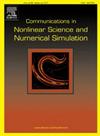非线性时间序列的多时滞模糊色散网络分析
IF 3.8
2区 数学
Q1 MATHEMATICS, APPLIED
Communications in Nonlinear Science and Numerical Simulation
Pub Date : 2025-06-25
DOI:10.1016/j.cnsns.2025.109078
引用次数: 0
摘要
复杂网络分析是分析非线性时间序列数据的关键。与传统方法不同,复杂网络不仅提高了数据的可视化,而且揭示了隐藏的模式和结构。然而,目前的网络构建方法往往过于简化节点转换,从而容易受到噪声的影响,忽略了重要的结构特征。为了克服这一限制,我们基于离散网络(DN)的最新发展引入模糊隶属函数,形成模糊离散网络(FDN)。FDN采用模糊隶属函数代替绝对映射,量化了节点划分的不确定性,增强了网络的信息表示能力。在FDN的基础上,我们还提出了多时延模糊分散网络(MTFDN),它从初始序列在不同的时延下生成复杂的网络,为时间序列分析提供了多个视点。最后,通过积分过渡熵值来描述网络复杂度,实现了高效的非线性时间序列分析。随后的仿真实验,对比了两种噪声和三种混沌模型,证明了MTFDN在非线性时间序列分析中的稳定性和对序列长度变化的低灵敏度。此外,在四类船舶和五种方位状态下进行的实验结果证实,MTFDN在实际应用中优于多时延DN等方法。本文章由计算机程序翻译,如有差异,请以英文原文为准。
Multi time-delay fuzzy dispersion network analysis of nonlinear time series
The use of complex network analysis is crucial for analyzing nonlinear time series data. Unlike traditional methods, complex networks not only improve data visualization but also reveal hidden patterns and structures. However, current network construction methods often oversimplify node transformations, which can lead to susceptibility to noise and overlook important structural characteristics. To overcome this limitation, we introduce fuzzy membership functions based on recent developments in dispersion network (DN), forming a fuzzy dispersion network (FDN). By employing fuzzy membership function instead of absolute mapping, FDN quantifies node division uncertainty, thus enhancing the network’s information representation. Expanding on FDN, we also present the multi time-delay fuzzy dispersion network (MTFDN), which generates intricate networks from the initial series at varying time-delays, providing multiple viewpoints for time series analysis. Ultimately, by integrating transition entropy values to depict network complexity, we accomplish efficient nonlinear time series analysis. Subsequent simulated experiments, comparing two types of noise and three types of chaotic models, demonstrate MTFDN’s stability and low sensitivity to series length changes in nonlinear time series analysis. Furthermore, experimental results, conducted on four classes of ships and five types of bearing statuses, confirm that MTFDN outperforms multi time-delay DN and other methods in practical applications.
求助全文
通过发布文献求助,成功后即可免费获取论文全文。
去求助
来源期刊

Communications in Nonlinear Science and Numerical Simulation
MATHEMATICS, APPLIED-MATHEMATICS, INTERDISCIPLINARY APPLICATIONS
CiteScore
6.80
自引率
7.70%
发文量
378
审稿时长
78 days
期刊介绍:
The journal publishes original research findings on experimental observation, mathematical modeling, theoretical analysis and numerical simulation, for more accurate description, better prediction or novel application, of nonlinear phenomena in science and engineering. It offers a venue for researchers to make rapid exchange of ideas and techniques in nonlinear science and complexity.
The submission of manuscripts with cross-disciplinary approaches in nonlinear science and complexity is particularly encouraged.
Topics of interest:
Nonlinear differential or delay equations, Lie group analysis and asymptotic methods, Discontinuous systems, Fractals, Fractional calculus and dynamics, Nonlinear effects in quantum mechanics, Nonlinear stochastic processes, Experimental nonlinear science, Time-series and signal analysis, Computational methods and simulations in nonlinear science and engineering, Control of dynamical systems, Synchronization, Lyapunov analysis, High-dimensional chaos and turbulence, Chaos in Hamiltonian systems, Integrable systems and solitons, Collective behavior in many-body systems, Biological physics and networks, Nonlinear mechanical systems, Complex systems and complexity.
No length limitation for contributions is set, but only concisely written manuscripts are published. Brief papers are published on the basis of Rapid Communications. Discussions of previously published papers are welcome.
 求助内容:
求助内容: 应助结果提醒方式:
应助结果提醒方式:


